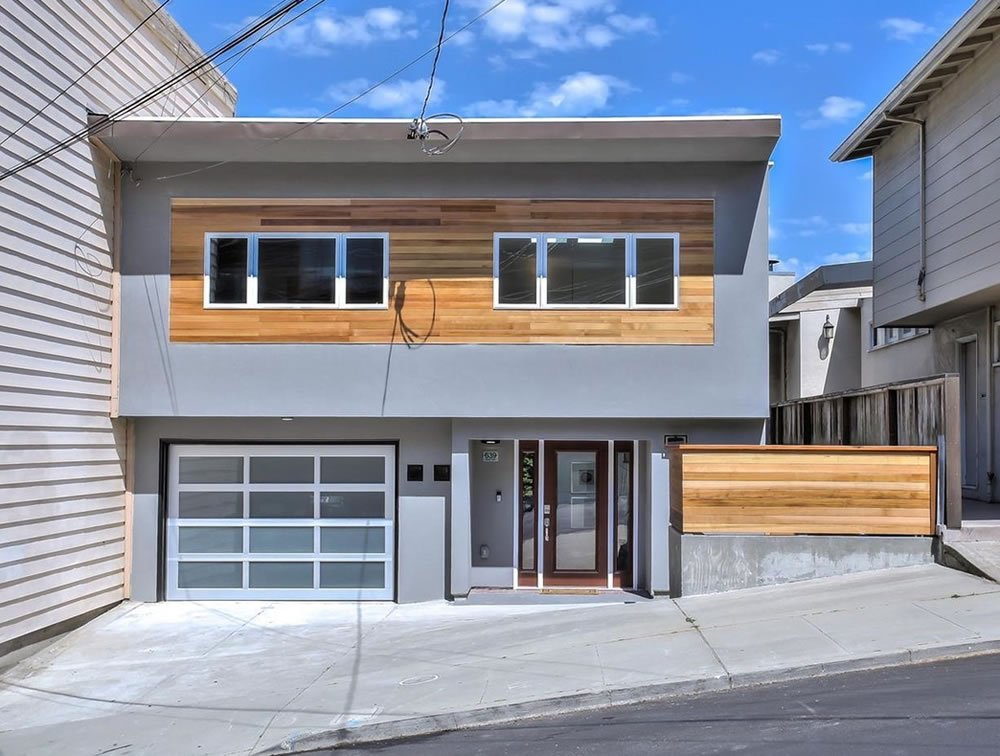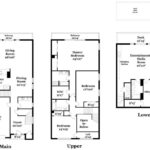The failed “Dreambuilders” flip of the Noe Valley home at 639 Grand View Avenue, which was foreclosed upon earlier this year and taken back by the financiers who were owed $3,576,411 on the investment, returned to the market with a $3,195,000 price tag in May having been completed and priced for a small profit at $3,995,000 in August of 2018.
And yesterday, the re-sale of the fully renovated and expanded 3,360-square-foot home closed escrow with a contract price of $3,075,000 or roughly $915 per square foot and $500,000 (14 percent) less than the investors had been owed.










Why does every single property need to be “”fully renovated” so that speculators can gouge more? Can’t we have anything that just remains affordable for the working class, or does everything have to be maximized, arbitraged, and exploited with subzeros, granite countertops, and bespoke finishes?
Just to be clear, I don’t blame the would-be flippers. The blame lies with the financiers offering historically-low interest rates that fuel asset bubbles that immiserate savers, the working class, and people on fixed incomes.Without banks offering nearly free money, there would be no housing or stock market bubbles that always destabilize the economy for the benefit of the .01% class, who are now on a path to own most housing in the US.
Inexpensive housing is available in many other parts fo the country (as well as outside of the United States). However, San Francisco has been gentrifying for many years as a result of high-income people wanting to live here. In the absence of the government telling people where they can reside (with inevitable corruption in that process), rationing housing by price is the most fair method available as it discriminates only on the ability to pay.
Most other locations outside of SF are less expensive, but many feel entitled to live where they want even if unaffordable. This is particularly true if they arrived earlier, and think that should provide rights over another person. As an example: I might prefer Monaco or Gstaad to my humble abode, but blame no one for my inability to afford those places.
The Native Americans upon whose land you now occupy might also believe you should leave, so they can afford to move back.
The point wasn’t demand varying across geography, the point was why does everything need to be stripped and renovated before being sold? What’s wrong with buying a house as-is? People used to do that all the time.
I for one would rather buy a pre-renovated house (and change what I want when I want) — than walk into a house that’s be gutted and rebuilt, and as a result of having spent $300K the owner now thinks they’re entitled to $500K more in price.
isn’t that the idea of flipping, deriving profit from the value that you put in by renovating. if you just buy and sell in the same condition then where’s the business model and how do you recover the transaction costs.
Yes, that is the business model, such as it is, for flippers.
The thing is, the market isn’t efficient because buyers, by and large, can over and over again be convinced to overpay for any renovation efforts put in by the flipper, and so much so that the flipper can cover their carry costs and still make a substantial profit.
Because “As is” was practically a ruin?
Trust me – there are tons of ‘as-is’ properties out there. After a short, but frantic search I’m in escrow on a house that was stripped to the studs, completely renovated and flipped. While I most certainly could have done the work for less, I did not want to deal with an ongoing construction project while trying to work from home. Plus, COVID uncertainty meant we might start something that would drag on for months. I was willing to pay a premium to know everything had been re-done in a 60 year old home. It helped that the finishes were exactly what my husband and I would have selected.
Someone willing to deal with the hassle of a major remodel can get paid for that by selling to someone who wants to buy a home “ready to enjoy”. I recently bought a home that had not been remodeled since it was built 55 years ago. Remodeling was a major pain but I was happy to be able to do things exactly to my tastes.
It is unlikely that a speculative flipper would have done things the way I did. I probably overspent on some things relative to what the market would pay for but I don’t plan to move anytime soon.
I believe his larger point was about the “affordability” of housing and not simply new countertops. What I was trying to point out is that affordable housing is available to everyone, but just not necessarily where people may feel entitled to live or of the renovated quality they might desire. We can always blame others for our not having what we want, but in democracies everyone has the choice of moving to a loss expensive location if they do not like the local situation. Or, take the risk of becoming a flipper or financier themselves to take advantage of the situation.
I do believe low interest rates create bubbles and cause larger economic problems down the road. However, these low rates are the creation of governments, rather than financiers. These elected or appointed officials pander to voters, who prefer to create long-term debts for later generations in the mistaken hope of avoiding inevitable economic cycles.
Or you can hear about all the programs, move across the country in a battered 1970s station wagon, park your so-morbidly-obese selves that you cannot even hope to ever work on the street, and have the taxpayers fund an apartment for yourselves!
“These elected or appointed officials pander to voters”
Nonsense. Most voters are oblivious to the fed funds rate, let alone the fed funds target rate that sets in motion the operations that determine the actual fed funds rate. Seniors – who always vote – are almost invariably savers, and low interest rates mean those on fixed incomes aren’t even keeping up with inflation. They are explicitly not being pandered to. Those being pandered to by low interest rates would be bankers, developers, landlords, used-house salespersons, and speculators in general, a decidedly small percentage of American voters.
As for your other point, everything, and I mean everything, in the economy is influenced by policy. If working people are forced to move because they can no longer afford to live near their family and friends, that is the result of policies that keep wages down and asset prices high. it would be very easy to design policies that increase wages and slow asset price growth, but those policies would cut into the profits of both the .01% class that controls American political economy and the 10% professional managerial class that serves them, like pilot fish.
The only “bubble” is in the purchasing power of the dollar. It is financially sound to load up on as much debt as possible given rates are below the inflation rate. It is literally free money being printed and handed directly to you.
This thing was bought for 2m and sold for 3m. It was *never* an affordable home.
I attended an absolute insane meeting where many callers claimed that $1.8m was the price of a home for starter families. I grew up in apartment buildings my whole life and turned out ok. The San Francisco neighborhood associations speak from a place of galling privilege.
What a confused comment. Are you complaining about homes being improved? Or that the present value of fixed income assets increasing due to low interest rates? If the latter, let me be clear: low interest rates can manifest as low rents (you need less income to justify the same construction costs) or high sales multipliers. Which one you get in practice is a policy choice, and San Francisco has chosen high multipliers.
This is also a confused comment. Rental rates are determined by how much landlords can get, not by what their costs are. Low rate fuel speculation, so you have more people buying up homes than actually want to live in them, which limits the supply of affordable homes, which are no longer affordable in any case because some flipper threw in a subzero and a soffit.
You’re the one who is confused, bemoaning flippers finishes choices when the case in point was an unlivable decrepit hovel. Further, your notion that most buyers would be OK with dated finishes and out of time systems as long as the bones are good is not in keeping with buyer behavior either.
“OK with dated finishes and out of time systems as long as the bones are good is not in keeping with buyer behavior either.”
But you make my point. It’s in keeping with with the behavior of speculators, foreign capital flight, and vulture capitalists, true, but it’s not in keeping with lower income buyers because those bespoke finished were installed precisely to push the price to a point that is beyond the ability of most people to pay.
I understand your resistance to this idea, though. Half the workday of used-house salespersons is spent extolling the virtues of improved, updated, and remodeled renovations, although some are also familiar with the virtues of “quaint,” “charming,” and “original.”
You make my point, actually. Well first you ignore the out of place nature of your original comment which doesn’t belong in this thread.
Then you go on to talk about “lower income buyers” in San Francisco. Then you talk about how half the workday is spent extolling the virutes of renovations, as if you earned a soapbox from which to opine in that manner. Give me a break. You have an idea and you want to talk about it. Fine. It’s wrong but whatever floats your boat.
I mean, sorry, “alf the workday of used-house salespersons is spent extolling the virtues of improved, updated, and remodeled renovations” ?? What a load of hoeey. You didn’t make any sort of point and you’re rude. Whatever.
“Charm, quaint, and original” all have their place and are used very frequently by “used house” salespeople. I mean obviously. All cases are different. Such as this one, where your take doesn’t, again, even belong.
The price landlords can get is a function of supply and demand. More supply can come online for a fixed demand curve if rates are low. There is little speculation in the San Francisco housing market as evidenced by extremely low vacancy rates. Most homebuyers in fact report buying in order to insulate themselves from rising prices, not to make money on their primary residence. There is a subtle but important difference between buying defensively and buying speculatively.
The reason this house is not affordable is because its owner also has to purchase an entire lot of San Francisco land. It’d be affordable if owning that land could be amortized across many owners. Same reason why public housing is *towers* not *single family homes*.
You know very little yet speak with a lot of confidence. Soffits aren’t even trendy anymore.
Might consider the zoning in SF as an issue. A Catch-22 for folks wanting to limit changes to the city and those that want to remain at “affordable “ prices.
That’s not on the banks, thats on the fed. And while i don’t disagree that they are likely causing bubbles, they are in a tough place as there is no political will for fiscal stimulus and the fed is just pursuing its dual mandate of low unemployment and price stability (inflation).
You are absolutely right that markets aren’t a panacea, but the Fed serves the major banks. The dual mandate is a normative farce and empirically not observed. Also empirical is that the Fed’s chief concern is propping up asset values. Decades of data show that Taylor’s rule is self-serving nonsense, but it’s still invoked because of the hegemony of neo-classical economics and the neo-liberal ideology it props up.
“[…] there is no political will for fiscal stimulus […].”
No pun intended, but there’s no agency in that statement. A lot of people clamor for the primacy of fiscal over monetary stimulus, just not the leadership of either major party, who are both beholden to the banks.
Real interest rates are set by the market, not the Fed. Real interests are low to negative because there is more desire to defer demand than there is for present consumption. The Fed can only control nominal rates.
The US government’s budget is at a huge deficit. What do you mean by no fiscal stimulus? We’ve been injecting money into the economy by spending at huge rates.
Needs more gray and white. In the furnishings, artwork, interior paint, exterior paint and even the landscaping. I always say you can’t have too much gray and white.
Two pontoons away from certified battleship status, for sure. The fleet grows by the day.
How did 3.5 million go into that flip? Must have been a hefty purchase price. They didn’t spend a dime on landscaping or outdoor space enhancements.
Dreambuilders purchased the permitted project for $2 million in June of 2014, after which it gutted, reconfigured and its depth was extended by 12 feet. The basement level was then converted into conditioned living space, with an additional bedroom, as well.
So did this just sit empty for six years?
The sticker on the range/oven suggests that it did.
Based on the 2014 purchase price and a 5.0% weighted-average-cost of capital (low estimate), compound interest/opportunity cost on the purchase price is about $680K. If the commission was 5% ($150K), that leaves $170K for the remodel at breakeven and without the flippers getting paid for their time and effort.
And how is not a high end property sitting empty for six years NOT speculation?
It is abundantly clear that a significant fraction of SF properties are ‘banked’ or otherwise ‘nonessential’ properties (be it pied a terre, short let’s etc). And this is part of the reckoning …
The glorified TV room is two levels above the kitchen. That alone is ridiculous, before even turning to the details of the interior design.
The media room is actually on the Lower level, below the kitchen (which is on the Main floor), with three bedrooms on the Upper/top floor above.
I don’t know anything about home prices in this neighborhood. That said, it seems like a high price-point given the quality of homes in the immediate area. Based on a quick tour of the ‘hood using Google Earth, the remodel appears to be overdone for the area.
Being set-back from the street, between two much larger unattractive structures, isn’t a positive feature.
I believe they call this a “Trump”
Gurl, that house is HEINOUS! So offensively ugly that this cannot be taken as a serious data point indicating anything other than poorly done flips don’t do well in anything but the most seller-friendly markets
It would’ve been more profitable and better for our rental market if this totally unremarkable property could have been demolished and expediently turned into 6-8 rental apartments. Why has the city decided against this?
Is it “the City” that decided against this, or the property owners (anticipating the reaction of the more vocial neighbors)?
This property is zoned for at most 3 units and < 50% lot coverage in a zone literally named "Low Density" so I think it is safe to say that city policy is opposed to putting 6-8 apartments at this address.
The zoning is not “literally” named Low Density – no such zoning exists. The zoning is RM-1 (apartments and houses) and allows 1 unit per 800 sq.ft. of lot area. This lot is 3,906 sq.ft. and therefore allows 4 units.
As an aside, it would good if people stopped littering conversation with literally – because you know – it literally makes you sound illiterate.
I don’t know why you thought you could outdo me in pedantry. You must be new here. Those of us who are literate can read that the RM-1 districts are — literally — called “Low Density” in the law.
LOL – sorry, I didn’t mean to knock you off the pedestal of pedantry !
However, if you filled out a SF building permit application and under Zoning you wrote in “Low Density” – you would be asked to correct it. The zoning is RM-1. Low density is part of the description of RM-1 zoning, but is not the zoning classification it self. Lots of zoning in SF is low density.
Also, in your original comment, you also state the zoning allows “< 50% lot coverage." Actually, RM-1 zoning allows 55% lot coverage from the front property line and possibly more by averaging the rear yard setbacks of each of the adjacent structures.
The market is not that inefficient, so blaming the city for any developer’s inability to satisfy their dreams of avarice will not aid one’s understanding. If this property were zoned to enable a real estate greedhead to easily turn it into 6-8 rental apartments the property would have sold for a (higher) price that reflected that fact, thus reducing the profit potential. And that assumes the buyer actually proceeded to build the apartments rather than “land bank” or flip the project to another developer once it was entitled, reducing the ultimate potential profit even more.
Anybody who has ever done a renovation know that there are dozens of shortcuts that will save you money short term, but which will cost you much more when they become evident. Flippers, of course, spend as little as they can, and all of it on stuff you can see. In my opinion, one should NEVER buy a flipper-remodeled house. It’s like buying a used car with painted Bondo hiding the rust holes.
It’s not just cars; there’s a lot of Bondo in construction, too. When I did apartment remodeling in the ’90s, we used to joke that we should have the Bondo brought in on a tanker truck and pumped up to the unit with two hoses.
like blown-in insulation…
Not true. Most builders take pride in their work, the seen and unseen. Plus everything gets inspected lots of times. So the only time what you are saying is true is a purely cosmetic no permits needed flip.
Oh, you mean the DBI with multiple cases brought and being ‘discovered’ by the Feds?
No, actually.
From the very piece linked to:
“forged civil engineer stamps and signatures on falsified special inspection reports, reports which were then submitted to the Department of Building Inspection instead of hiring special inspectors to actually complete the work.”